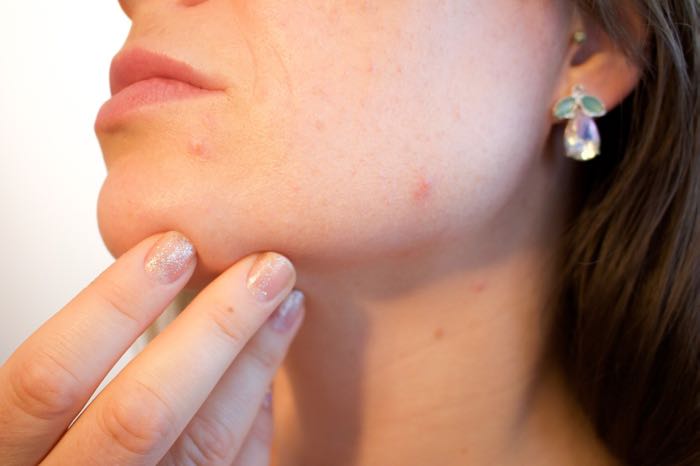
You’re fixing your hair one night, and ouch! One small misplacement of the curling iron and you have a red spot on your cheek. Ugh. It’s going to scar. You know it’s going to, and you didn’t need more flaws on your face!
What can you do to fade these and other scars away? We have some tips for you.
What is a Scar?
A scar is a sign that your body had to repair an injury. Whenever you injure your skin, such as with a cut, scratch, or acne breakout, the body goes to work repairing the damage. If the injury is minor, new skin will form over the top as it heals. If the injury penetrates into the deeper layers of skin, the body has to make new tissue to cover it. Usually that new tissue is thicker than the original, which is what makes up a scar.
At first, scars appear pink or red, but over time, they tend to change color to be either lighter or darker than the surrounding skin.
10 Ways to Smooth and Fade Scars
1. Take good care of the wound in the first place.
The best time to reduce visibility on a scar is right after the injury takes place. If you are careful to tend to the wound as you should, you can minimize the scar that’s created. First of all, keep the area clean to avoid infection. Gently wash the area with mild soap and water. It’s imperative, while the wound is healing, to stay out of the sun or use a powerful sunscreen to avoid permanent discoloration.
Next, keep the wound moist so that it doesn’t form a scab. Scabs take longer to heal, and can create deeper, larger scars. Our Restorative Skin Balm works great as a wound moisturizer. It helps speed healing, while ingredients like castor oil smooth out some of the fibrous tissues to soften and make the scar less noticeable.
Clean the wound and change the bandages daily, and once the wound heals, continue to protect it from the sun. That can help prevent it from going dark, and may also help it fade faster.
2. Use vitamin C.
Vitamin C applied to the scar can help fade discoloration. Find a vitamin C serum or powder that you can use daily on the area. Give it several weeks to see if you notice a difference.
3. Exfoliate regularly.
Eliminating dead skin cells on the surface of the scar can help it appear less noticeable. Regularly exfoliate the area with your favorite exfoliating product, or you can use a baking soda/water paste applied to the area for a couple minutes each day. Another good option is apple cider vinegar and honey.
4. Try natural extracts.
There are some natural extracts that have a good reputation for helping to fade scars. Onion extract is one of the best, as it has bioflavonoids linked to scar removal. In one study, people who used onion extract reported improvements in scar softness, redness, and texture after four weeks. Simply apply daily directly to the scar. Other options include lavender, tea tree oil, rosehip seed oil, and carrot seed oil.
5. Get sour.
Lemon has natural alpha hydroxy acids (AHAs) that can help naturally lighten any area of skin. Cut a lemon in half and either squeeze the juice onto the scar, or simply place a lemon slice or quarter on the scar and hold there for about 15 minutes. Rinse well afterwards. You can also use lemon juice.
6. Apply turmeric powder.
Turmeric is good for skin for a lot of reasons (which is why we include it in our CV Skinlabs products), and one of them is that it can lighten skin. It actually targets the melanin in skin, which provides the pigment, and reduces it so that the discoloration fades. Mix some turmeric powder with a little honey and then apply the paste to the scar for about 20 minutes. Rinse thoroughly.
7. Treat with vitamin E.
Vitamin E is a helpful wound healer, but it can also help fade scars over time. Open a vitamin E capsule and apply the liquid directly to the area daily.
8. Use a silicone sheet.
Studies have shown that silicone sheets and silicone gel can gradually improve a scar’s appearance. In one 2002 study, for instance, researchers found that silicone gel sheets had sufficient evidence behind them in helping to manage a wide variety of scars. You can find silicone scar treatment products at your local pharmacy, or ask your doctor for help.
9. Try gentle fruit acids.
Glycolic acid, salicylic acid, and mandelic acid can all reduce the look of acne scars, in particular, including dark acne marks. In a 2009 study, researchers found that both glycolic acid and salicylic-mandelic acid combinations were effective against acne scars, but the combination products were best for post-acne hyperpigmentation.
10. Ask your dermatologist about laser treatments.
If nothing else works, you can talk to your doctor about laser treatments. These are usually reserved only for stubborn and persistent scars. Lasers can be really effective, but make sure you understand all the risks before moving forward.
How do you manage scars?
Sources
Zoe Diana Draelos, “The Amility of onion extract gel to improve the cosmetic appearance of postsurgical scars,” Journal of Cosmetic Dermatology, May 13, 2008, https://onlinelibrary.wiley.com/doi/full/10.1111/j.1473-2165.2008.00371.x.
Vijay Kumar Garg, et al., “Glycolic Acid Peels Versus Salicylic-Mandelic Acid Peels in Active Acne Vulgaris and Post-Acne Scarring and Hyperpigmentation: A Comparative Study,” Dermatologic Surgery, January 5, 2009; 35(1): https://onlinelibrary.wiley.com/doi/full/10.1111/j.1524-4725.2008.34383.x.
Mustoe TA, et al., “International clinical recommendations on scar management,” Plast Reconstr Surg., August 2002; 110(2):560-71, https://www.ncbi.nlm.nih.gov/pubmed/12142678.

